소개
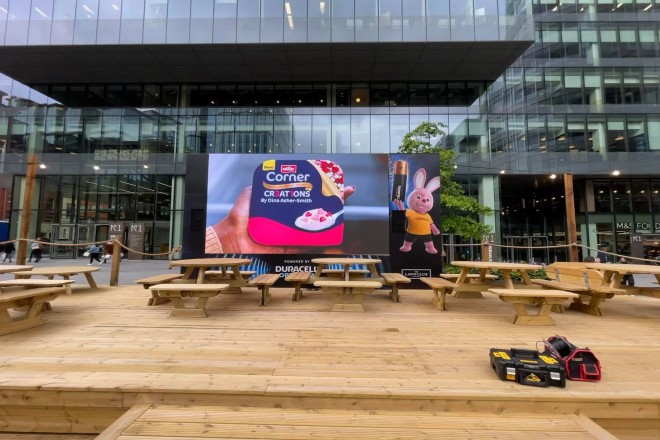
Public space is a relatively core human living area in the whole society. It is also becoming more and more technological and convenient with the changes of the times.
발광 다이오드 표시 스크린 are also increasingly used in public spaces with the progress of the times. So how can LED display screens effectively use public space to “serve” mankind?
1. How should public space be defined and classified?
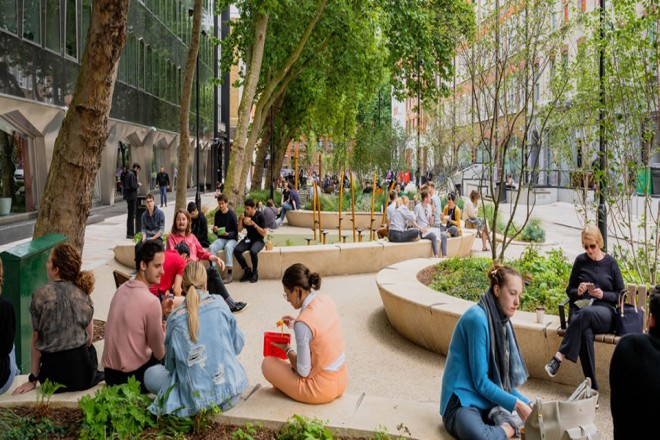
If we compare the place where we live to a house, your own private residence is like your room, and the public space is like the “big living room” in the city. It is a place where everyone can go in and sit and chat. No matter who you are or where you come from, as long as you want, you can find a small world of your own here.
There is no threshold here, no entrance fee, and no question about your identity. It is so open and inclusive. Public space is not only a stage for urban life but also a small world for our neighbors to communicate emotions and display culture. It makes the city no longer cold but full of human touch and vitality.
1). So what are public spaces?
1.1). City square
Just like the living room at home, the city square is the place where everyone can get together to chat, dance, and watch the excitement. During holidays, there may be cultural performances or fireworks shows, which are simply a happy party in the city.
For example, the Place de la Concorde in Paris not only has beautiful fountains and statues but is also the first choice for the French to celebrate festivals and hold gatherings. Every time you go there, you can feel the strong festive atmosphere.
1.2). Commercial Street
The commercial street is a good place for us to go shopping, shopping, and eating. From high-end luxury goods to street snacks, there is everything. When you are tired of shopping, you can find a cafe to sit and enjoy a slow time.
For example, Oxford Street in London is a paradise for shoppers. From high-end brands to affordable stores, there are a lot of things to see, and the buildings on both sides of the street are also full of historical sense, which makes it a unique experience to walk around.
1.3). Transportation hub
The transportation hub is like the blood vessels and nerves of a city, connecting people from all over the place. Whether you take a train, subway or plane, this is a must-go place. Although sometimes it is crowded, it is also for the convenience of “just go”.
For example, New York’s Grand Central Station is a historic building with gorgeous interior decorations. Every time you enter and exit the station, it feels like traveling through time and space. There are also many delicious and fun things around, so you won’t be bored while waiting for the train.
1.4). Parks and green spaces
Parks and green spaces are the “lungs” of our city, providing us with fresh air and a place to relax. On weekends, take your family or friends to the park for a walk, a bike ride, or a picnic. It’s so wonderful!
For example, London’s Hyde Park has large lawns, beautiful lakes, and leisurely swans. Every time you go there, you can feel the tranquility and beauty of nature. It is a good place to relax.
1.5). Building exterior walls
Don’t underestimate those building exterior walls. They have now become a good place to showcase urban culture and art. Sometimes, it’s a light show; sometimes, it’s a huge painting. You can enjoy these free “art exhibitions” while walking on the street.
For example, Shibuya 109 in Tokyo is a fashionable building. There are often various creative decorations and light shows on the exterior walls. Every time you pass by, you can feel the youth and vitality.
2. What is the application value of LED display screens in public spaces?
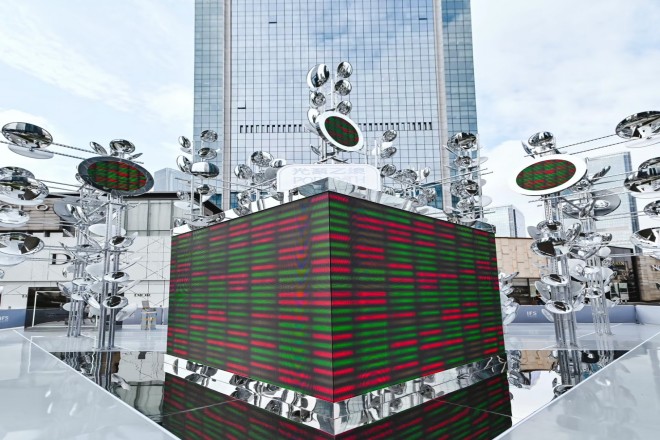
1). Information dissemination:
Imagine that you are rushing to the company and suddenly want to know what the weather is like today or whether there is any important news. Don’t worry.
look up at the nearby LED display screen; it is like your “portable secretary,” scrolling the latest weather forecast and news information in real time and even quickly issuing notifications in emergency moments so that you can grasp the “fresh” things at the first time no matter where you go.
This instant and intuitive way of information transmission is more convenient than swiping a mobile phone!
2). Commercial promotion:
Walking on a busy commercial street, have you ever been attracted by those colorful and dynamic advertisements? Yes, that’s the credit of LED display screens. It makes brand promotion no longer limited to static posters but becomes a vivid and interesting dynamic advertisement.
Whether it is a new product launch of a fashion brand or a special recommendation of a restaurant, it can find a place on the LED display screen. This novel and eye-catching promotion method not only makes the brand more vivid but also allows consumers to be planted unconsciously while enjoying a visual feast.
3). Cultural display:
Do you think art can only be appreciated in 박물관 or galleries? Then you are out! Now, LED display screens have brought art to you. Whether it is an art exhibition in the streets or a theme display at a festival, LED display screens can easily handle it.
It uses the changes of light and shadow to present artworks to the public in a new form, allowing people to feel the charm of culture in their daily lives. This down-to-earth way of cultural display makes art no longer out of reach but within reach.
4). Public service:
In such a big city, sometimes finding the way and finding information is also a headache. However, with LED display screens, everything has become much simpler. It is like your “intimate assistant,” providing you with accurate flight information and train schedules at transportation hubs such as 공항 and railway stations.
공공장소 등에서 병원 and schools, it publishes medical guidelines and educational information for you. This convenient and efficient public service method allows you to feel the warmth and care of the city wherever you go.
3. Strategies for LED display screens to effectively use public spaces
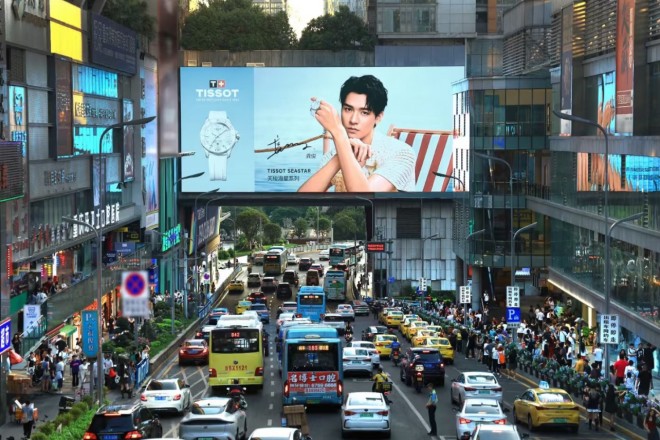
Using LED display screens in public spaces is not just a matter of hanging them up. If you want it to truly become a beautiful landscape in the city, you have to pay attention to some strategies. Next, let’s talk about the “4” strategies for how to increase the value of LED display screens in public spaces.
Step 1: Planning and layout:
First, you have to choose the right LED screen according to the space’s characteristics. For example, a large one is used in a large square, and a small one is used in a small alley so that people can look at it comfortably.
Then, you have to consider where people stand to see it best. The screen must be adjusted to a suitable angle and height so that people don’t have to look up or down. In addition, it must match the surrounding environment and not be too abrupt, like an outsider. The lighting must also be adjusted well so as not to dazzle people’s eyes and cause light pollution.
Step 2: Content innovation and management:
The content must be fresh and interesting, and it must keep up with current hot topics and the local cultural atmosphere. You can’t always play the same few things over and over again, and people must feel refreshed when they see them.
You also need an entire intelligent content management system, which can be updated and adjusted as you want, which is very convenient. Also, the audience must be able to participate, such as the entire touch screen or somatosensory interaction, so that everyone can play and have fun.
Step 3: Policy support and supervision:
The government must be strong. Some policies must be introduced to encourage innovative applications, such as giving some financial support, or reducing taxes. Some norms and standards must be established to ensure that the LED display is installed safely and maintained in a timely manner.
The content must also be reviewed well, so as not to create anything inappropriate, and to maintain public order and a good social atmosphere.
Step 4: Community participation and feedback:
The last step is to let community residents participate. They are the most direct users and viewers, and their opinions and ideas must be listened to. Let them participate in content creation and selection, so that everyone will have a stronger sense of belonging after watching it.
A feedback mechanism must also be established, so that everyone can say what they are dissatisfied with or have good suggestions, so that timely adjustments and optimizations can be made to meet everyone’s needs.
4. Typical case analysis
1). 3D LED display in Seoul, South Korea
On the streets of Seoul, South Korea, a 3D LED display called “Big Water Tank” is popular for its realistic visual effects. This display is actually a 20-meter-high and 80-meter-long curved LED screen located on the roof of SMTown in Seoul, South Korea.
It simulates the state of waves surging and rolling in the building, presenting an amazing effect, even making passers-by wonder, “Is this real water or a screen effect?” The following is an analysis of this success case, including its success factors and inspirations.
1.1). Success Factors
- 기술 혁신:
The display uses curved LED screen technology to simulate the dynamic effects of waves. This technological innovation is the key to attracting audiences. At the same time, the screen can automatically adjust the brightness according to the movement of the sun to prevent visual inconvenience to passers-by and vehicles.
- Artistic Fusion:
The design team District combines technology and art to create stunning visual effects through digital media technology. This fusion of art and technology not only enhances the viewing experience of the display but also increases its cultural connotation.
- 사용자 경험:
The display not only provides visual shock but also simulates the sound of waves through audio, bringing visitors an immersive experience. This all-round sensory experience enhances the user’s sense of participation and satisfaction.
- Utilization of public space:
The display is located on the roof of SMTown, the most famous building in Gangnam District, Seoul, which is a public space with high traffic. By making rational use of public space, the display can attract more audiences and enhance its influence and communication effect.
1.2). Inspiration
- Technological innovation is the core driving force:
In the digital age, technological innovation is the core driving force for the development of public space art. By introducing new technologies, new materials and new processes, more unique and shocking visual effects can be created, and the artistic quality of public space can be improved.
- Integration of art and technology:
The integration of art and technology is an important trend in the development of public space art in the future.
Through digital media technology, augmented reality technology and other means, art works can be presented to the audience in a more vivid and intuitive way, enhancing the appeal and communication of the works.
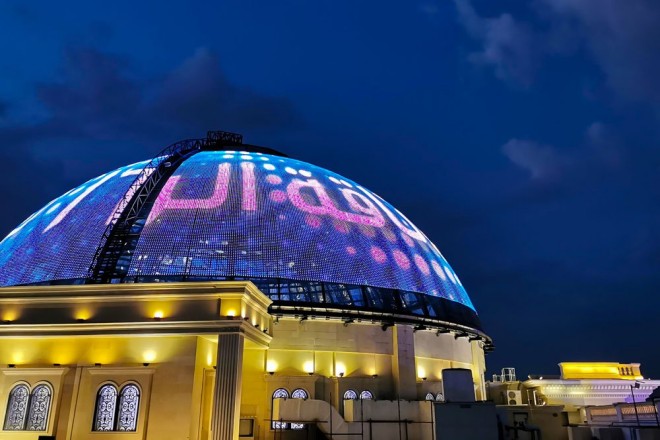
2). Dome Sky Screen in Doha, Qatar
The Dome Sky Screen in Doha, Qatar, is a huge LED display screen that covers the dome of a stadium or public building, providing audiences with stunning visual effects.
2.1). Success factors:
Large scale: The sky screen covers a wide area and has stunning visual effects.
Advanced technology: Use high-quality LED display screens and advanced control technology to ensure smooth and clear images.
2.2). Inspiration:
When installing LED display screens in public spaces, you can consider creating a large-scale display system to attract more audiences and enhance the overall visual effect. At the same time, attention should be paid to technological advancement and picture quality.
3). Comprehensive analysis
Technological advancement is the foundation: We can see that these successful cases all use advanced LED display screen technology and control technology to ensure clear, smooth and stable images.
Creative design and content innovation are the key: Successful cases often focus on creative design and content innovation, attracting the audience’s attention and enhancing the overall experience through unique visual effects and rich content.
Harmonious coexistence with the surrounding environment is the trend: More and more successful cases are beginning to explore ways to integrate LED display screens with the surrounding environment or building structures to achieve more beautiful and harmonious visual effects.
결론
In summary, through careful planning, content innovation, and the coordinated promotion of policies and communities, LED display screens have become an indispensable part of public spaces, which not only enhances the city’s information dissemination and cultural display, but also finds a balance between energy conservation and environmental protection and humanistic care.
마지막으로 LED 디스플레이 화면에 대해 더 알고 싶다면, 우리에게 연락해주세요.
